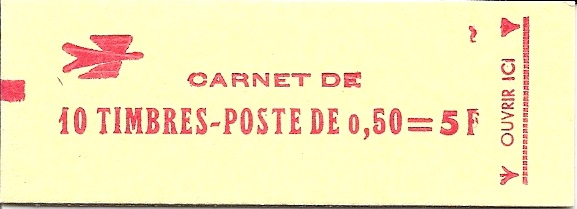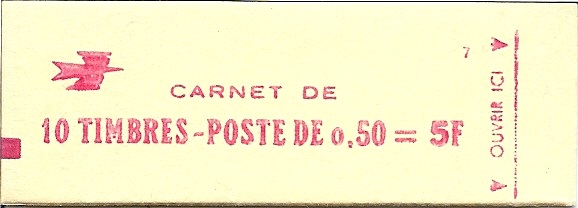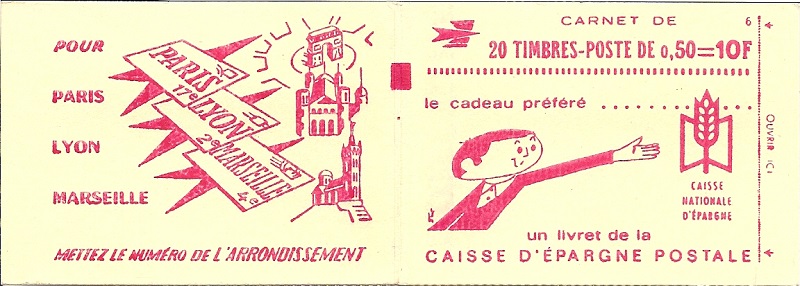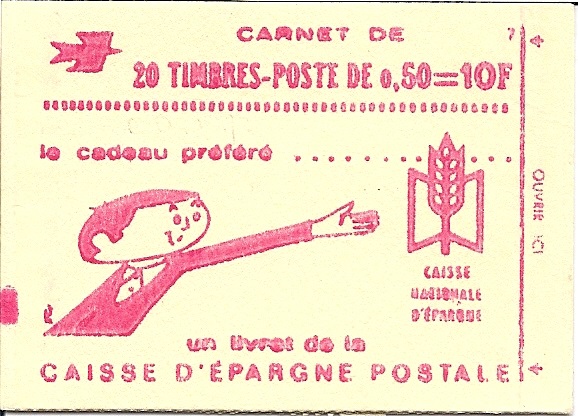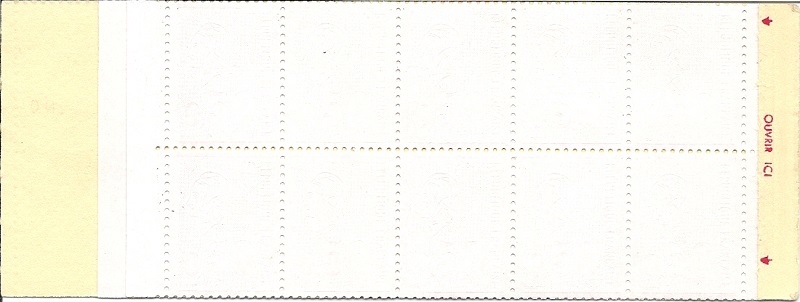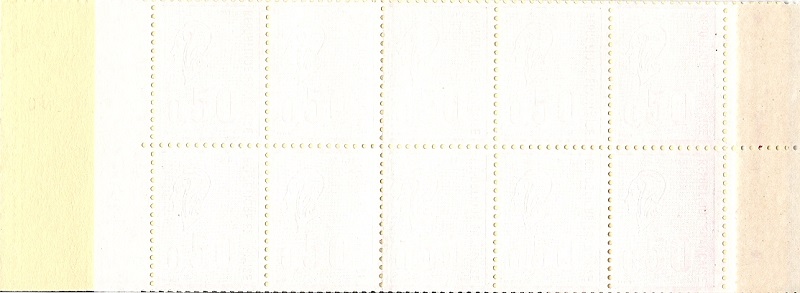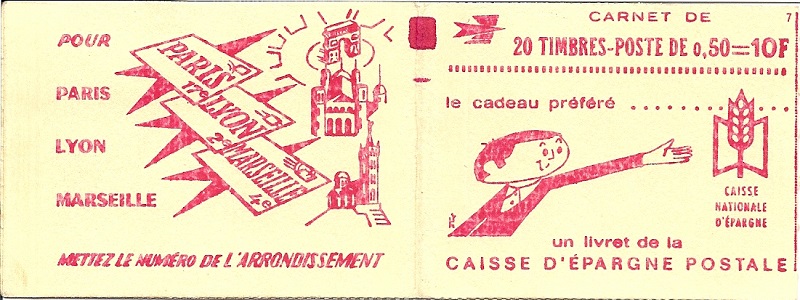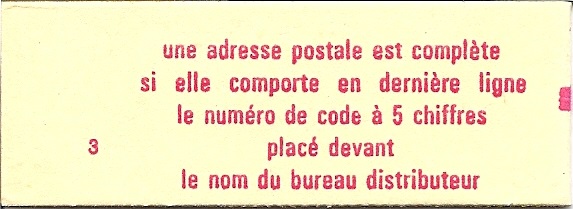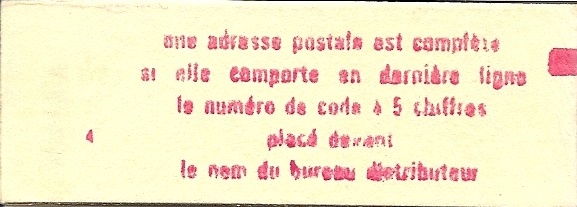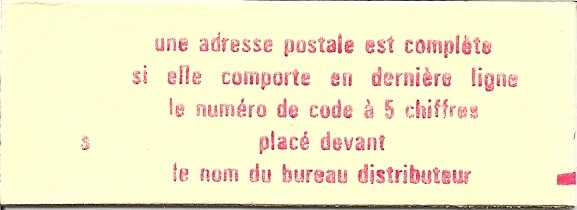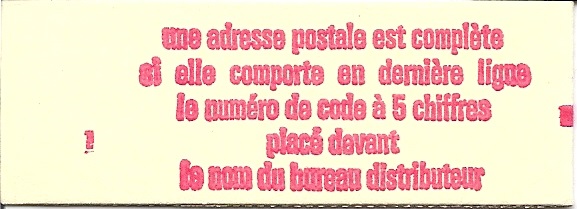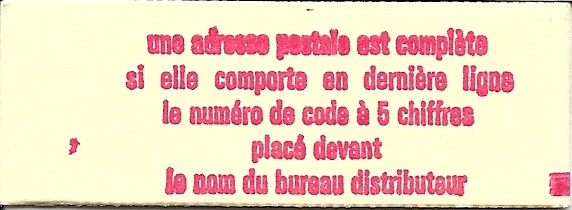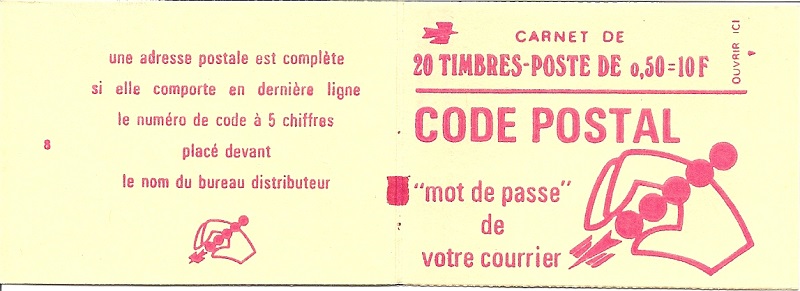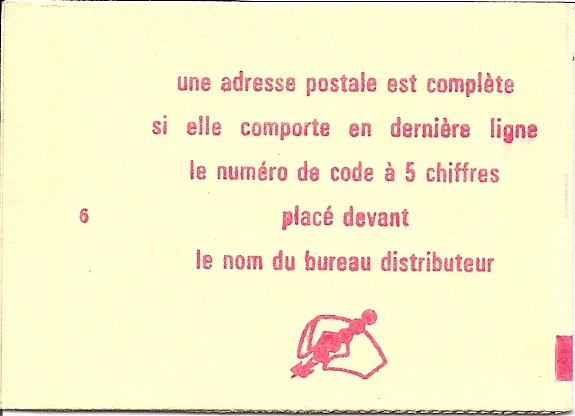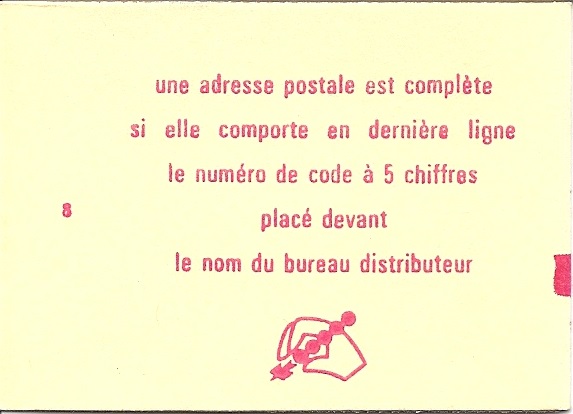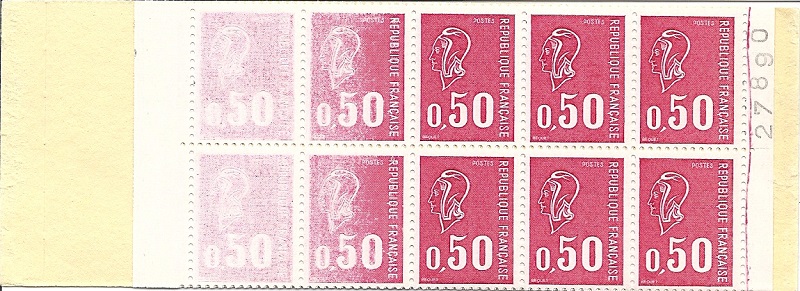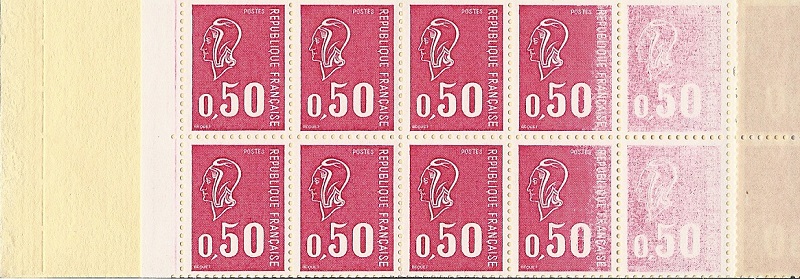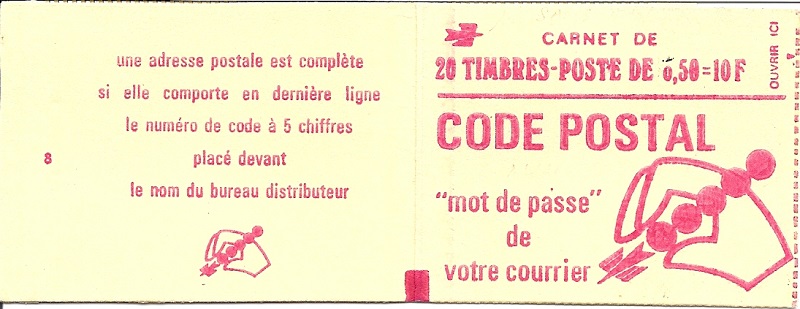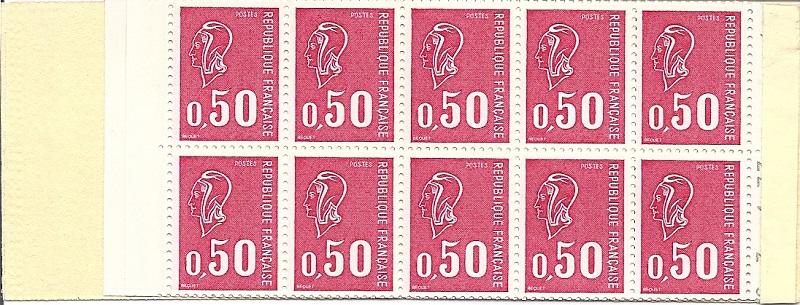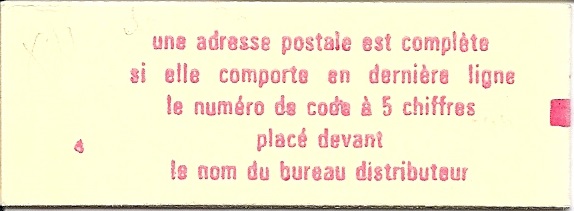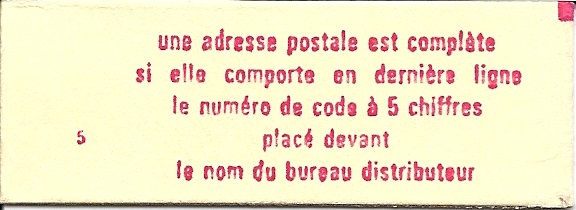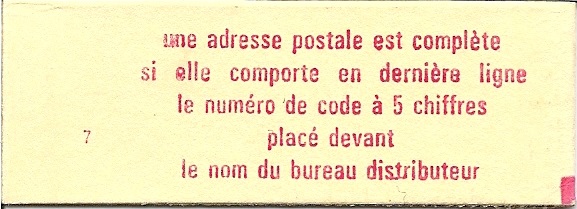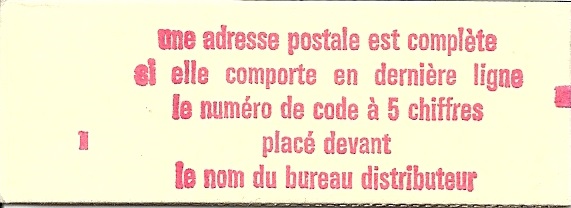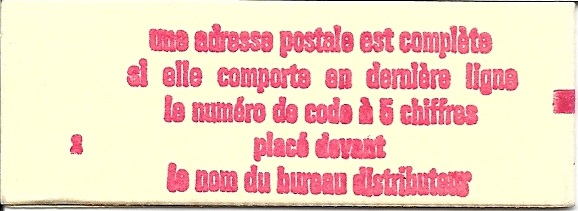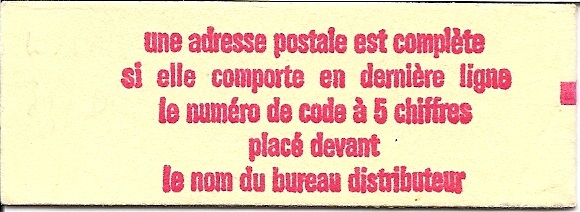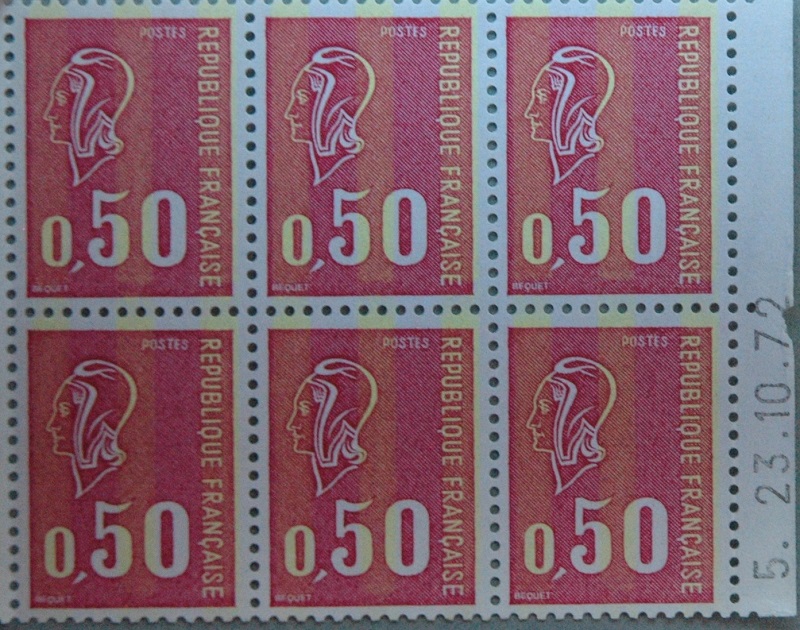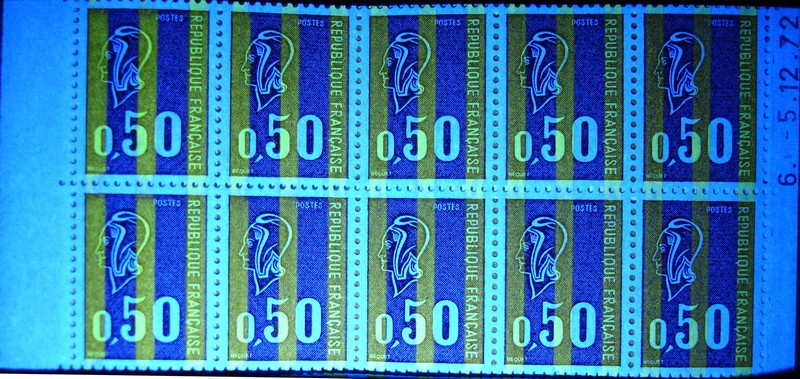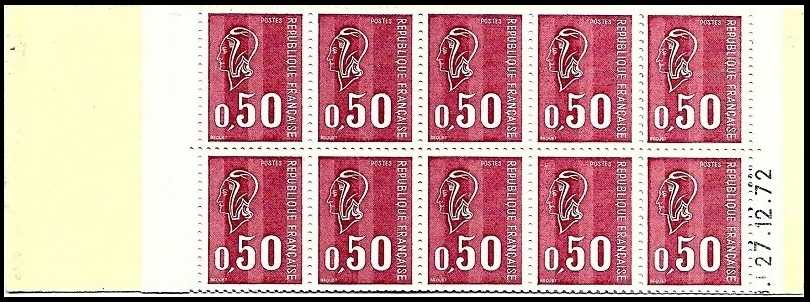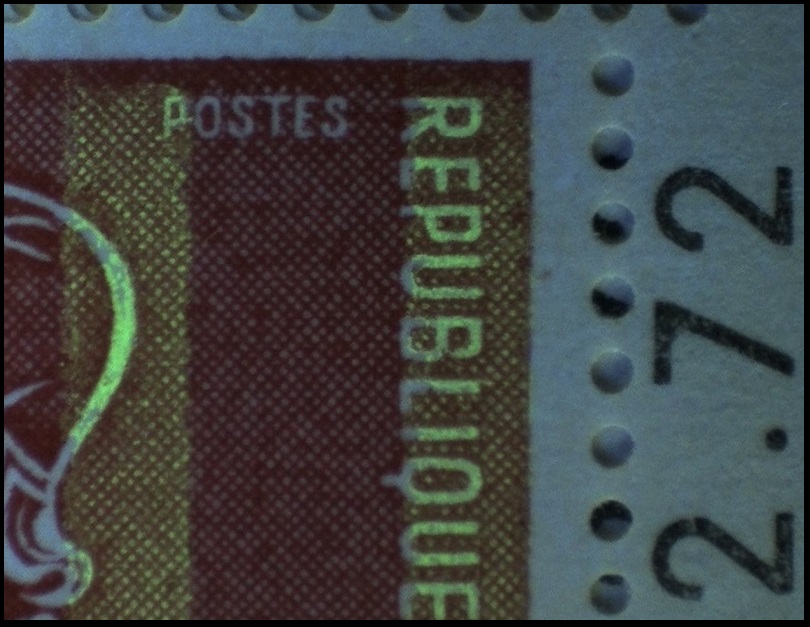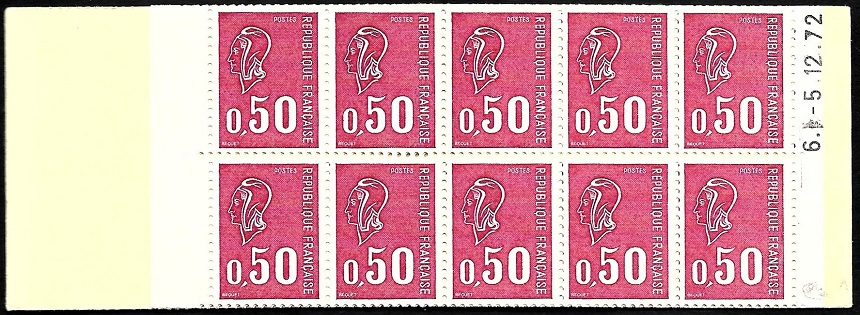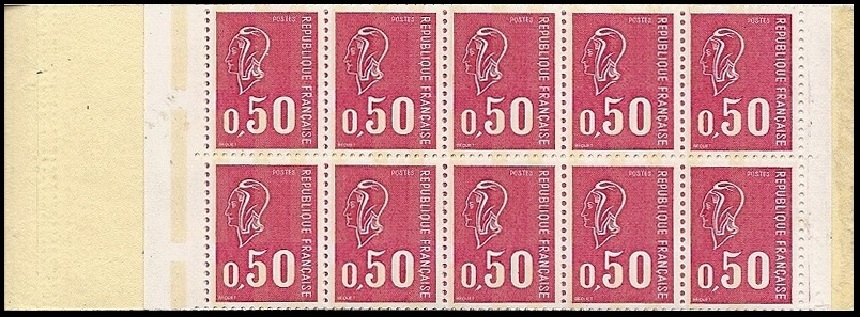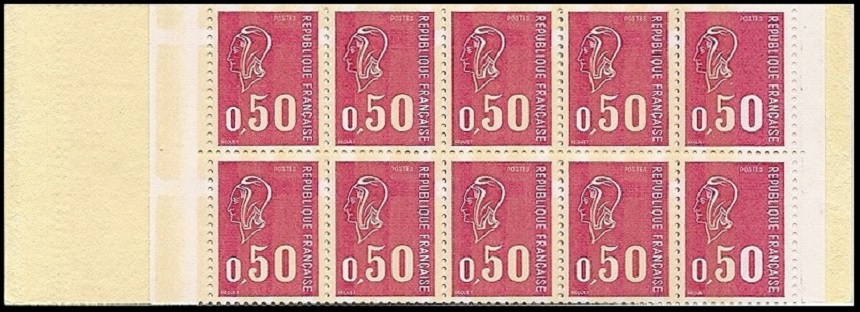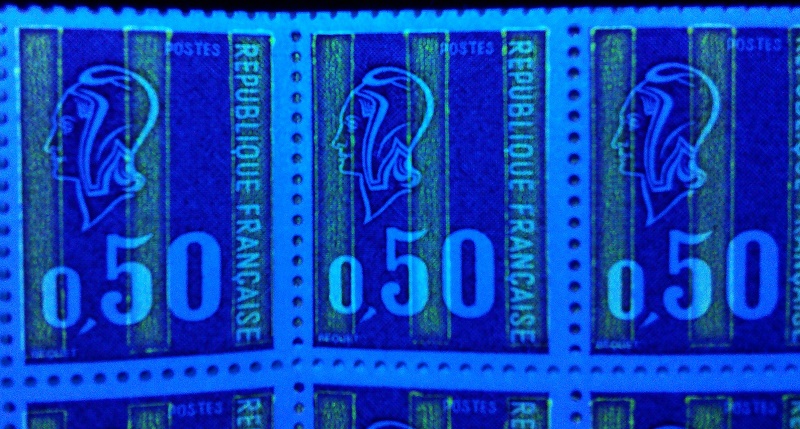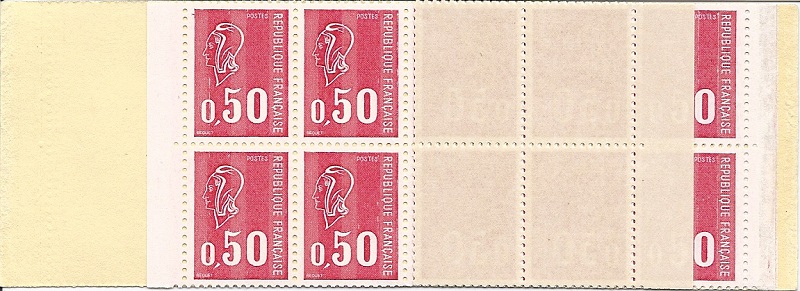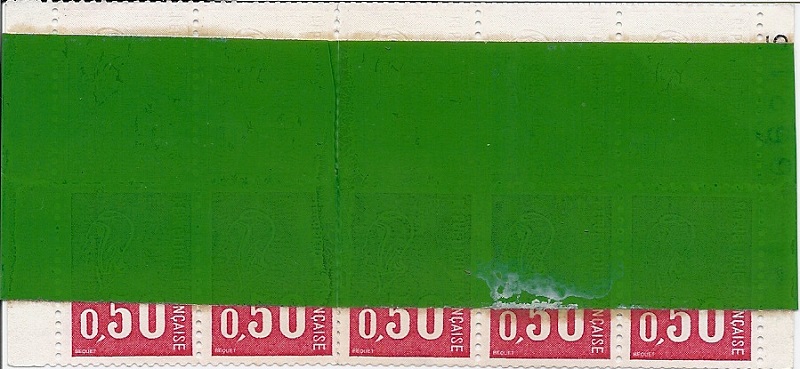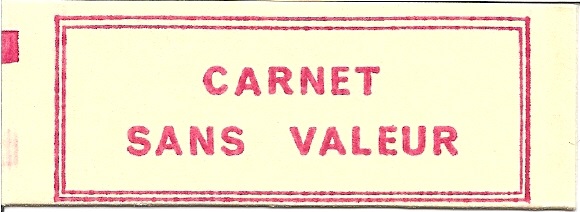
Introduction
We will now describe and illustrate all the booklets produced with the stamp 0,50F Marianne de Béquet. We will also show some varieties about these booklets, varieties which can be extremely spectacular. This is due to the way in which these booklets are made: booklets arrive closed in front of the checking person and booklets with missing colour, defective printing, misperforations,... can completely escape the attention of the printing office staff and thus can be found in post offices.
We will end this article by proposing some test booklets linked to those containing stamps 0,50F Marianne de Béquet, as well as two booklets produced for the PTTs postal courses.
The C1 type booklet
It is a booklet of 10 stamps without phosphor band, with a cover advertising the “Caisse d’Épargne Postale”:

Booklets C1 were produced from 04.12.70 to 06.05.72 through the presses TD6-3, 6-4, 6-5 and 6-6. Covers were printed through the packaging machines number 1, 2, 3, 4, 5, 7 and 8.
Here are finally some varieties affecting C1 type booklets:
The C2 type booklet
It is a booklet of 20 stamps without phosphor band, with a cover advertising the “Caisse d’Épargne Postale”:

C2 type booklets were produced from 08.12.70 to 18.05.72 on the presses TD6-3, 6-5 and 6-6. Covers were printed through the packaging machines number 6, 7 and 8.
Here is now a variety concerning a C2 type booklet:
The C3 type booklet
It is a booklet of 10 stamps without phosphor band, with a cover advertising the use of the 5-digit zip code introduced in March, 1972, without dotted lines:

C3 type booklets were produced from 02.05.72 to 11.04.73 on the presses TD6-5 and TD6-6. Covers were printed through the packaging machines number 3, 4, 5 and 7:
The C4 type booklet
It is a booklet of 10 stamps without phosphor band, with a cover advertising the use of the 5-digit zip code, with dotted lines added to inform the user of the side from which it is necessary to open the booklet:
C4 type booklets were produced from 28.02.73 to 17.04.73 on the presses TD6-5 and TD6-6. Covers were printed through the packaging machines number 1 and 2.
The C5 type booklet
It is a booklet of 20 stamps without phosphor band, with a cover advertising the use of the 5-digit zip code, without dotted lines:
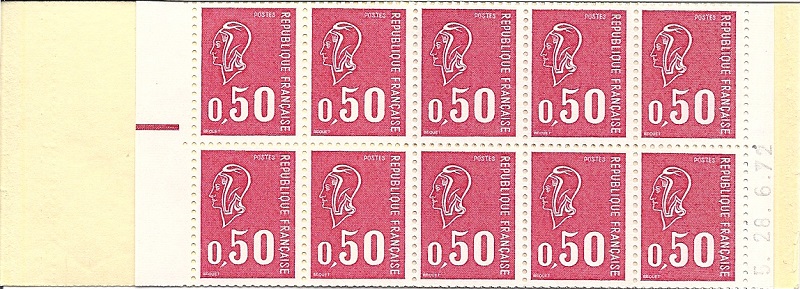
C5 type booklets were produced from 06.06.72 to 07.04.73 on the presses TD6-5 and TD6-6. Covers were printed through the packaging machines number 6 and 8.
Here is now a C5 type booklet with defective printing stamps:
The C6 type booklet
It is a booklet of 20 stamps without phosphor band, with a cover advertising the use of the 5-digit zip code, with dotted lines:
C6 type booklets were produced on 31.5.72, 3.1.73 and 17.11.73 on the press TD6-5. Covers were only printed on the packaging machine number 8.
The C7 type booklet
It is a booklet of 10 stamps with three type B phosphor bands and a cover advertising the use of the 5-digit zip code, without dotted lines:
C7 type booklets were produced from 02.01.73 to 26.07.74 on the presses TD6-4, 6-5, 6-6 and 6-7. Covers were printed through the packaging machines with number 3, 4, 5 and 7 and without number.
Here is finally a C7 type booklet with 10 albinos:
The C8 type booklet
It is a booklet of 10 stamps with three type B phosphor bands and a cover advertising the use of the 5-digit zip code, with dotted lines:
C8 type booklets were produced from 14.02.73 to 31.07.74 on the presses TD6-5, 6-6 and 6-7. Covers were printed through the packaging machines number 1 and 2 and without number.
The C9 type booklet
It is a booklet of 20 stamps with three phosphor bands and a cover advertising the use of the 5-digit zip code, without dotted lines:
C9 type booklets have a peculiarity: they are the only ones among all the booklets with stamps 0,50F Marianne de Béquet to have been produced with two types of phosphor bands:
Type A bands
Description of the printings
- Some C9 type booklets with three type A phosphor bands can be found in the French Postal Museum’s archives. Here are two pictures of these booklets:
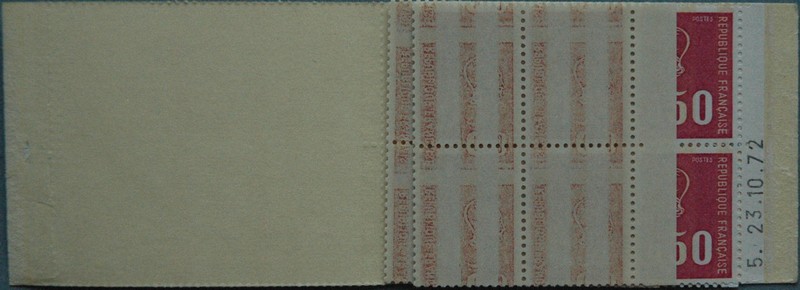 un-issued C9 booklet dated 23.10.72 (Source : Copyright Coll. L’Adresse Musée de La Poste, Paris / La Poste)
un-issued C9 booklet dated 23.10.72 (Source : Copyright Coll. L’Adresse Musée de La Poste, Paris / La Poste)
This booklet, dated 23.10.72, arises from the press TD6-5. We may see, on the upper image, phosphor ink traces on the reverse side of the stamps: it is ink rub-off due to the not still dry ink of the previous turn of the reel. This date of 23.10.72 was never found in post offices. It is thus probably an unissued booklet.
- On the other hand, booklets produced from 04.12.72 to 05.12.72 with three type A phosphor bands are known:
 inside of a C9 booklet with type A phosphor bands: it is an "aristo" booklet made on the press TD6-6 on 5.12.72 with the electronic mark number 8
inside of a C9 booklet with type A phosphor bands: it is an "aristo" booklet made on the press TD6-6 on 5.12.72 with the electronic mark number 8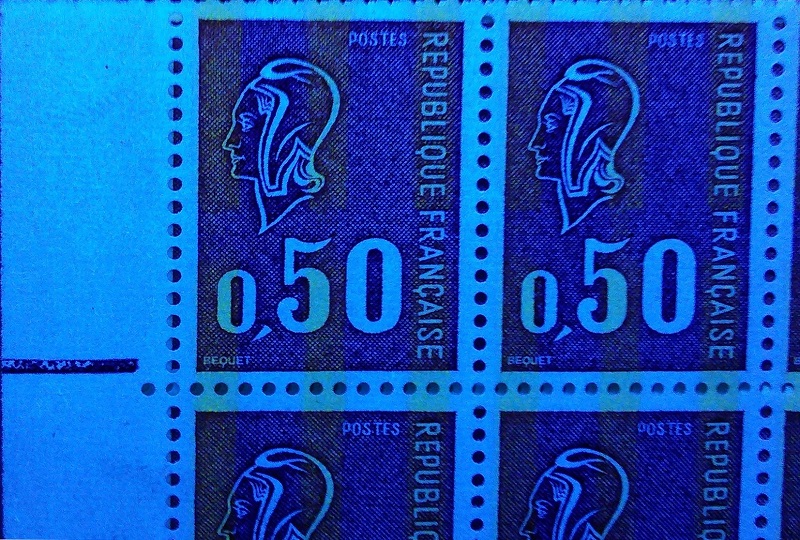 enlargement of the stamps of the above booklet under U.V. showing the vertical offset of the phosphor bands
enlargement of the stamps of the above booklet under U.V. showing the vertical offset of the phosphor bands
Personally, I have only seen such booklets with a cover made on the packaging machine number 8.
- Finally, I have a booklet dated 27.12.72 whose stamps are certainly of type A (cf. photo under UV of the top pane of this booklet below). To the best of my knowledge, that booklet has never been mentioned. It seems to have been produced on the TD6-6 press.
Some curious varieties
I will now describe five booklets with different varieties, but similar in the sense that the two parts of the booklet have phosphorescent bands arranged differently, This means that the two reels of stamps used to make these booklets are not twin reels obtained by cutting the same continuously printed reel.
- Booklet #1: no phosphorescent band
For this first booklet, the upper pane is totally free of phosphorescent band, while the lower pane has type A phosphorescent bands arranged normally. It should be noted that the stamps were printed on the press TD6-6 on 5.12.1972 and that the cover of the booklet was made on the packaging machine number 8.

Photo under UV light of the upper pane of the above booklet. 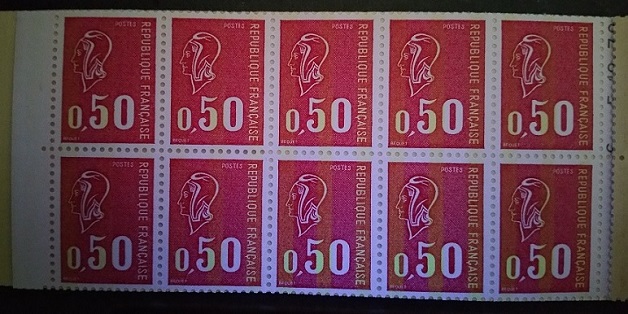
Photo under UV light of the lower pane of the above booklet. - Booklet #2: vertical offset of 50% of phosphorescent bands
This booklet has an upper pane with a vertical offset of the phosphorescent bands 16 mm upwards and a lower pane where the phosphorescent bands are printed normally. Here, too, the stamps were printed on the press TD6-6 on 5.12.1972 and the cover of the booklet was made on the packaging machine number 8.

Photo under UV light of the upper pane of the above booklet. 
Photo under UV light of the lower pane of the above booklet. - Booklet #3: Horizontal offset of phosphorescent bands
This booklet has an upper pane with continuous phosphorescent bands with a horizontal offset of 6 mm to the left. On the lower pane, the phosphorescent bands are printed normally. Note that the horizontal offset of the phosphorescent bands creates two stamps adjoining to the right margin with only two phosphorescent bands. The cover of this booklet was made on the packaging machine number 8.

Photo under UV light of the upper pane of the above booklet. 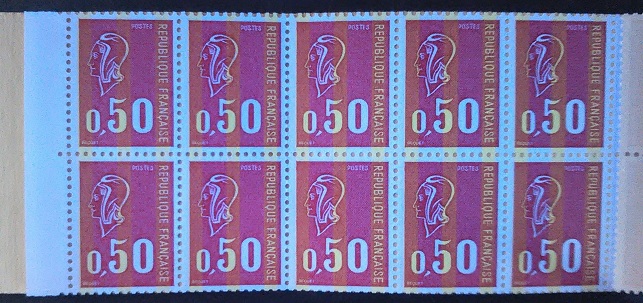
Photo under UV light of the lower pane of the above booklet. - Booklet #4: Horizontal and vertical offset of phosphorescent bands
This booklet has an upper pane whose stamps show a vertical offset of the phosphorescent bands of 6 mm downwards and a horizontal offset of 11 mm to the left. On the other hand, phosphorescent bands are wider (4.5 mm) than normal bands. On the lower pane, the phosphorescent bands are printed normally. It can be noted that the horizontal offset of the phosphorescent bands creates two stamps adjoining to the right margin with only one and a half phosphorescent band (the middle phosphorescent band straddles the perforation). The cover of this booklet was made on the packaging machine number 8.
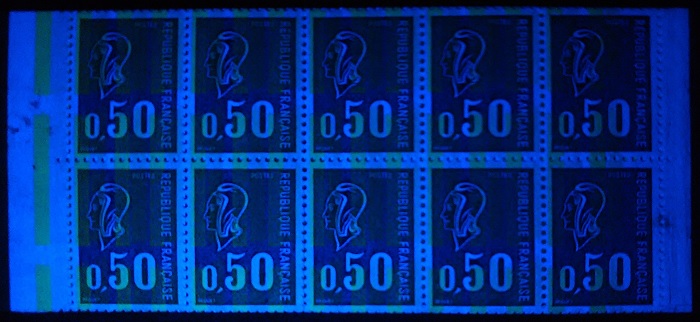
Photo under UV light of the upper pane of the above booklet. 
Photo under UV light of the lower pane of the above booklet. - Booklet #5: horizontal and vertical offset of phosphorescent bands
This second booklet has an upper pane whose stamps show a vertical offset of the phosphorescent bands of 10 mm upwards and a horizontal offset of 7.5 mm to the left. On the lower pane, the phosphorescent bands are printed normally. Note that the horizontal offset of the phosphorescent bars creates two stamps adjoining to the right margin with only two phosphorescent bands. The cover of this booklet was made on the packaging machine number 8.
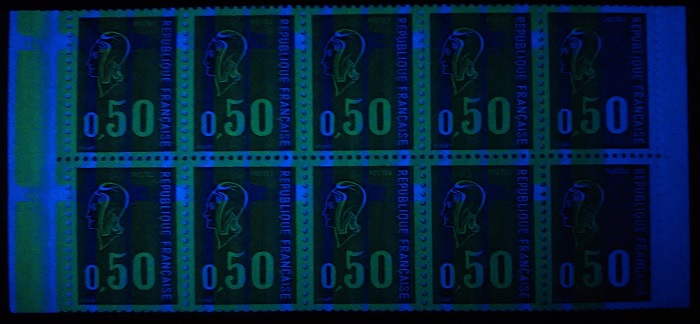
Photo under UV light of the upper pane of the above booklet. 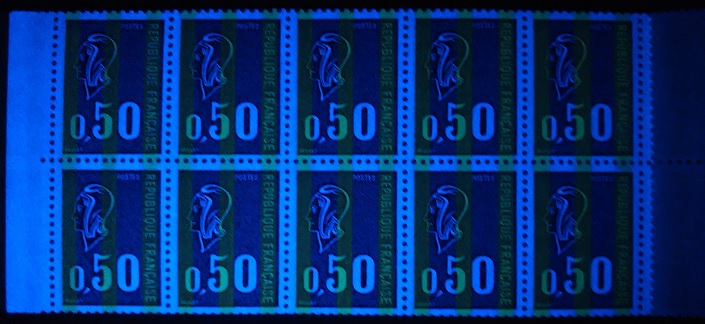
Photo under UV light of the lower pane of the above booklet. Type B bands
All the other known printings for the C9 type booklet are with three type B phosphor bands. They were printed on the presses TD6-5, 6-6 and 6-7, from 02.01.73 to 31.05.74.
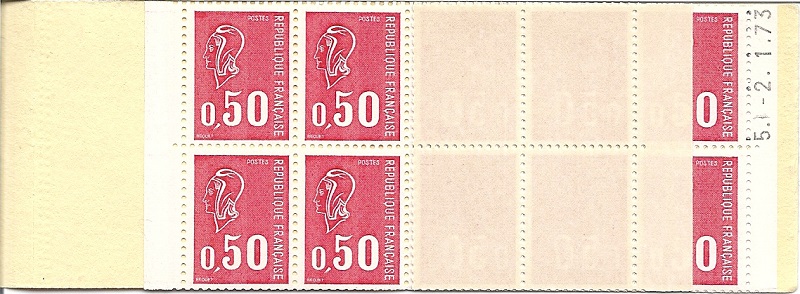 inside of the above booklet: booklet dated 2.1.73 (first day issue of the stamps with type B phosphor bands?)
inside of the above booklet: booklet dated 2.1.73 (first day issue of the stamps with type B phosphor bands?)Here is another C9 type booklet with really recognizable type B phosphor bands:
Covers were printed through the packaging machines number 6, 8 and without number.
The C10 type booklet
It is a booklet of 20 stamps with three type B phosphor bands and a cover advertising the use of the 5-digit zip code, with dotted lines:
C10 type booklets were produced from 14.05.74 to 24.07.74 on the press TD6-7. Covers were only printed by means of the packaging machine number 6.
To end this part on the description of booklets containing stamps 0,50F Marianne de Béquet, I would like to show a rather unusual pane of booklet:
It is a booklet pane reconstituted with a green Scotch tape connection. The top of the pane is made up of a strip of 5 albinos and the bottom of a strip of 5 normally printed stamps. We may note that both strips are very slightly moved. According to a former employee of the I.T.V.F., it would be " a join of reels of stamps on the packaging machine to remove a part damaged during the line-engraving printing ". The driver of the machine would have put damaged items without covers in a special box intended for scrap pieces. But this pane of booklet would have escaped the destruction.
Test booklets
A number of test booklets with type 2 Palissy vignettes (size 18x22,5 mm, perforated 13x13) are known. These booklets were produced for the manufacturing of booklets or the adjustment of stamp vending machines (cf. the brochure Les carnets d’essais de G. GOMEZ):
Booklets for the PTTs postal courses
Two types of booklets, without a stamp, were made for the PTTs postal courses during the period of the stamp 0,50F Marianne de Béquet. They were used by the pupils of postal worker courses to proceed to the counting of their sub-cash register, but were also intended for the adjustment of cutting machines or of booklet vending machines (cf. the brochure Les carnets d’essais de G. GOMEZ):



